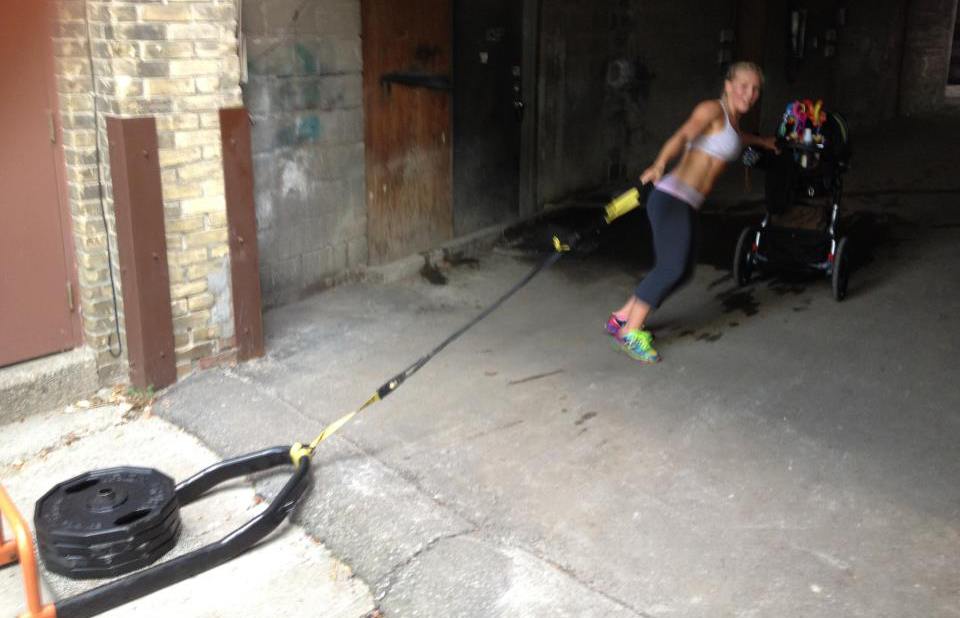What to Expect When You're No Longer Expecting?
Imagine being pregnant for nine or 10 months (yes, 10), and then the next day ... you're not.
Unless you've been there, it's tough to wrap your head around the shift your clients are going through.
As their trainer, you have two primary goals:
- Help them feel like a normal, functioning woman, and enhance their general well-being for daily life. Baby brain, anyone?
- Help them move, perform, and feel better in their new body.
Here's how you can do it.
Getting Back Into the Gym
Most guidelines advise waiting six weeks before returning to structured workouts.
But a lot of factors can affect the return date. A client who's experienced an uncomplicated vaginal delivery, with minimal tearing, might feel ready to train just two or three weeks postpartum. Someone who's had a Caesarian section, a traumatic birth, or an infection might not be ready for several months.
With most clients, you can encourage walking and other light activity as soon as they feel ready for it, which will help with recovery and their sense of normalcy. But the last thing you want to do is pressure the client to return to their workout routine. They don't need the stress of feeling guilty or obligated.
Depending on your client's history of exercise and current condition postpartum, you will need to determine how much exercise actually happens in your initial sessions. I use the following answer from Alwyn Cosgrove on how to train cancer patients. Not that your postpartum clients are "sick," but they're going through major physiological changes, and are understandably exhausted. So, how do you start training a previously pregnant client? The answer: with low, low, low, low, low volume. And, don't forget low volume.
Remember goal #1: Always make them feel better when they walk out than when they walked in.
Job Title: Nanny/Trainer
Semiprivate sessions will take on a whole new meaning. Child care is not easy or cheap, and you'll likely have moms bring their babies to their sessions. If possible, you and your gym should encourage it. It will make it much more likely for new moms to continue their post pregnancy workouts with you postpartum.
You don't have to love babies or even be that comfortable around them to train postpartum women, you just might have a few wee ones sitting in on your sessions now. Moms can have baby hang out in their car seats, or on a mat on the floor with some toys when they get a bit older. Don't worry if a mom asks you to hold their baby; they won't judge your awkward football cradling.
How to Fix the Mummy Tummy
Ah, the dreaded mummy tummy. Getting rid of it is often the stated goal of post-pregnancy workouts. Of course, gaining fat during pregnancy can be a factor of this, but more importantly your diastasis recti (DR) plays a starring role.
DR was covered in the prenatal article, but to recap it is the resulting separation of the rectus abdominis muscles that often occurs in pregnancy, as the linea alba becomes stretched and remains lax postpartum. A diastasis is commonly thought to be a two finger or more width separation of the rectus muscle bellies from the midline. The abdominal wall stretches (often, a lot), and so the connective tissue can widen leaving the recti bellies with a gap between them. This is one reason why your postpartum clients may still look four months pregnant when their baby is a year old. No one likes to be asked when they're due when they're not even pregnant anymore, right?
Step 1: Retraining the Breath
It might seem simple, but you will have to teach them how to breathe again. You will likely encounter women with flared ribcages and paradoxical breathing (read Mike Robertson's breathing work here to understand proper diaphragmatic breathing using the core). They could be constantly breathing through the chest and shoulders, which is wreaking havoc on their posture and their ability to stabilize the core. We're left with one big, rib-flaring, unstable, inefficient core.
We want the client to feel a gentle softening of their pelvic floor and abdominals on their inhale breath, and a gentle contraction of their pelvic floor and abdominals on their exhale breath. Get them breathing properly and watch the ribcage become aligned in a better position over the pelvis. Only then you will actually get proper abdominal contraction and compression to close the DR. Molly Galbraith wrote a great article on a case study with this exact issue, and will show you how to fix it.
Step 2: Retraining the Abdominals
There are going to be some jiggly bits and bellies going on, and that's perfectly normal. Ladies recently postpartum will likely feel like are having a tough time getting a solid abdominal contraction, especially in the lower rectus region. They might feel like there are no abdominal muscles left, like they have a serious case of abdominal amnesia. Those muscles have been overstretched, not functioning at capacity for months, and don't know how to turn on anymore. Practice makes perfect here.
What abdominal exercises should you do? As mentioned, the diaphragmatic breathing exercises for the core should be in every workout and every day life. These will begin reprogramming the pelvic floor and transverse abdominis in order to gain tension in the linea alba and help close the DR. Low level dead bug exercises, side planks, Pallof presses, and carry exercises will be their new best friend in order for the client to train their alignment and recruit their deep core muscles.
What abdominal exercises should you avoid? In the case of DR, you need to steer clear of exercises on all fours, front loaded planks, and any supine crunching or flexion movements. They are only going to put more pressure on that weakened connective tissue and exacerbate the separation.
Be cautious of rotation exercises and any loaded exercise where the core has to stabilize a ton. When your client is going from supine to seated or standing, get them into the habit of rolling to their side before coming up instead of jackknifing up and bulging the belly. And, be sure your clients know that front loading baby carriers need to go until that DR is closed as to avoid increased pressure on the abdomen.
Step 3: Retraining the Pelvic Floor
"I laughed so hard, tears ran down my leg." Nothing should ever be that funny.
To avoid seriously embarrassing leakage accidents, get to know the pelvic floor. Imagine the pelvic floor like a dome. It is a group of muscles and soft tissues supporting the region from pubic bone to base of the spine, and connecting the sitz bones that hold the organs in place. The pressure of the fetus, along with labor and delivery, can weaken the tone of these muscles. Pelvic floor dysfunction can range from hypotonic muscles not closing the badder sphincter with enough strength, to a uterine prolapse.
Kegels, pelvic floor contractions, should be done daily (for as long as they can remember to do them) and incorporated into your sessions. In your movement prep, get in the habit of doing one or two sets of 10 repetitions with your diaphragmatic breathing exercises. You can progress these into your strength work, for example on the upward movement of a squat they draw the pelvic floor up. Please, no jumping jacks. No running, no squat jumps, no box jumps, until that pelvic floor is rock solid (many months postpartum).
"I Just Want My Pre-Pregnancy Body Back"
Believe me, if I had a dollar for every mom that said this to me, I definitely wouldn't still be spending my winters in Calgary. There's no magical quick fix. Reinforce that it took their body almost a year to transition in growing a baby, so it's probably not going to take anything less to return to that previous version of their body. Try to explain that this is about reinventing the body in the long term, not getting back to what they were.
Just like prenatal training, correcting alignment and developing posterior chain strength are going to be the main ingredients of your workouts. Get the pelvis in a neutral position, the upper body less kyphotic, and build strong glutes. In your first few training phases, you likely won't need to program in metabolic activity to get a training effect. Not only unnecessary, but uncomfortable due to breasts that are doubled in size and unsafe with relaxin still providing loose ligaments and tendons.
Final Thoughts
A woman's body is going through significant change after pregnancy, just as it did during. Your job is to design a program to rebuild their strength and fitness level with proper progression. If she's used to intense workouts or training for competition, reframing the idea of what a workout should feel and look like is imperative.
Remind them that the most important thing they can do for themselves and their child is to take care of themselves, and not put themselves last. Proper nutrition, hydration, and activity will help them navigate their sleep-deprived fog.











